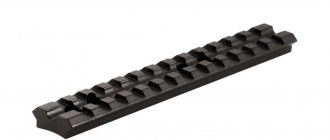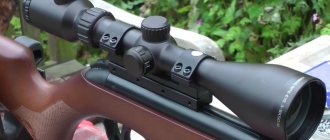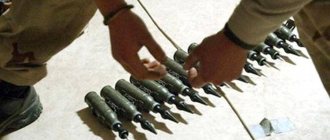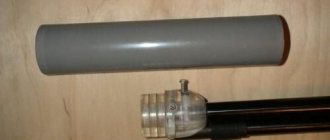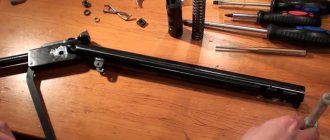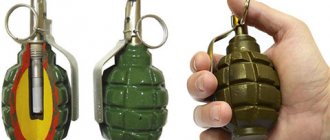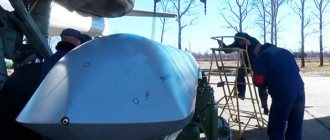- October 27, 2018
- Weapons and ammunition
- Natali Michaelis
The speed of aiming and the accuracy of the bullet hitting the target have been the main requirements for firearms since their invention. Over time, these figures increased due to the improvement of rifles and carbines with the help of various devices. One of the modifications of small arms is a collimator sight based on electronic technology. This unit allows you to quickly aim at an object and fire an accurate shot. Read our article about how to properly sight a red dot sight.
What is a collimator?
A collimator sight is a device designed for aiming at medium distances. The operating principle of such a unit consists of several optical effects, which are complemented by simple electronics. A light source is directed into the reflector lens, after which a whole stream of rays is formed in the direction of the arrow. At this time, the person holding the weapon in a combat position sees in front of him several dozen dots collected into a single pattern. Depending on the displacement of the weapon’s axis, these points move along the lens, which allows you to quickly and accurately target an object and fire a shot.
Operating principle and difference from other types
When using a weapon with a standard open sight, the shooter has to combine three objects on one axis at once: the front sight, the rear sight and the target. Only after this condition is met can a person be sure that the ballistic projectile will fly exactly to the target. This method significantly reduces the aiming speed and almost completely eliminates the possibility of firing while moving.
The optics provide good accuracy, but shooting while moving is absolutely impossible due to the strong vibration of the mark. High accuracy is achieved only with a stable position in one place and even breathing. Therefore, optical sights are used for shooting at long distances.
A collimator sight has a number of advantages over these two types. Firstly, it allows shooting at close and medium distances. Secondly, the speed of aiming increases significantly due to the absence of the need to combine several objects on the same axis. The accuracy of aimed fire while moving also increases.
In long-range shooting conditions, the collimator is not as good as optics. The device simply will not allow the shooter to aim at an object from a distance of more than 200 meters, since the red dots on the lens will completely cover the silhouette of a deer or wolf. Therefore, the sighting range ranges from 10 to 150 meters, depending on the model.
Also, do not forget that the collimator will require a power source to operate. In most cases, this role is performed by ordinary batteries or a mini-battery. Therefore, its advantage over other sights remains exactly until the charge runs out. After this, aiming will simply become impossible.
Features of the red dot sight
The fundamental technical difference between this model and other types of sighting devices is that it does not have a permanent front sight or reticle. Aiming is based on directing a beam of light into the shooter's eye using a lens, which is compared with the target and gives very accurate guidance to the target.
With a slight deviation of the weapon along the horizontal or vertical axis, the mark also moves, still indicating the direction of flight of the bullet. Such qualities are unimaginable for other types of sighting devices.
Principle of operation
The design of a collimator sight involves the use of simple electronics and optical effects. The light source is directed into a reflector lens, which generates a stream of light in the direction of the shooter. A person holding a weapon in a firing position sees this flow in the form of a point, which moves along the lens depending on the displacement of the weapon’s axis relative to the shooter’s axis of view and makes it possible to quickly and accurately point the weapon at the target to fire a shot.
The collimator takes advantage of human binocular vision, giving the shooter the ability to aim without covering the other eye.
Difference from other types of sights
When using a standard open front sight, the shooter must align his gaze, the front sight on the nose of the barrel and the rear sight on its near edge on one axis before firing. Only when these conditions are met can the person firing the shot be sure that the bullet from the barrel will fly in the right direction. This method reduces mobility during shooting and visibility, since the shooter needs to close the second eye so that binocular vision does not interfere with accurate targeting.
When using an optical sight, shooting while moving is almost impossible due to strong vibrations of the mark. High shooting accuracy in this case is achieved by a stable position of the weapon, in which it is possible to point the crosshairs at the target. For such measured shooting, only conditions of large distances between the shooter and the target are permissible - the conditions of sniper shooting.
This device allows for accurate shooting at close and medium distances. All that is required is to combine the direction of view and the light flow, after which the shooter sees where the bullet will hit. Compared to a conventional open sight, a red dot sight, whose operating principle allows you to spend a shorter period of time on aiming, gives more space for accurate shooting while moving.
In conditions of long-distance shooting, the collimator does not allow accurate shooting, since the marker can cover almost the entire target, so it does not compete with sniper optical devices.
An important difference between a collimator and other devices is the use of electricity for operation. Without power, the light source will stop working, making accurate aiming impossible. Therefore, when using a device of this type, you should remember that it works until the battery runs out.
Application
Since their appearance, red dot sights have spread to many areas of human activity related to weapons. Besides military and police units around the world, they are most common among hunters and airsoft players. In some cases, the collimator is even placed on the bow.
This device is suitable for almost any type of small arms intended for close and medium ranges, including heavy shotguns and even machine guns. So what is a red dot sight for? Shooting in combat conditions or regular hunting with a collimator sight will definitely become easier and more convenient after you get used to it.
Types of collimators
Collimators are divided into open and closed. Initially, these classes meant two types of collimator sights, significantly different in their structure.
Closed devices in the classical sense were those that did not have a transparent lens. Through it, the shooter did not see the space behind the sight with the eye that sees the front sight.
Aiming was achieved by the need to use two eyes at once, one of which sees the space ahead, and a mark is projected onto the second by a collimator. Thanks to binocular vision, the human brain in this case compares different images from two eyes and the shooter sees the front sight in front of the target and can take aim.
Open was a model with a transparent lens and an open front wall. Through such a sight the target is visible. Therefore, shooting with a collimator sight using only one eye is possible only with an open type.
With the development of collimators, the need for closed sights in the classical sense has disappeared. There is a new understanding of the difference between closed and open devices. Nowadays, an open sight is a sight in which the lens is fixed in a small frame and does not have an auxiliary protective structure around it.
A closed device is a device in which the focusing lens is located in a sealed structure consisting of a massive frame and an additional front lens. This design protects the focusing lens from raindrops, dirt and other foreign objects that can spoil the quality of aiming. It is precisely this understanding of the concepts of closedness and openness that is widespread at the present time.
Operation, care, storage rules
To ensure that a high-quality collimator does not fail during shooting, you need to install it only on weapons with the appropriate caliber. The device, intended for pistols and light semi-automatic weapons, cannot be installed on weapons with high recoil, as this can quickly disable it.
It is quite easy to damage this device. The lenses do not withstand any physical impact well; they are easily scratched, which reduces the quality of aiming. It is better to wipe them from dust using special napkins and without using improvised means, as some fabrics can leave scratches.
Batteries are inserted into the device only before shooting and removed after shooting. When storing weapons, batteries must be kept separate to protect the electronic parts of the device from possible damage if the batteries fail.
It is also advisable to remove the device while transporting the weapon, or use special cases that protect it from possible physical impact.
How to choose?
When choosing, first of all you should know what caliber weapon it will be installed on.
When choosing from models designed for weapons of a suitable caliber, you need to understand that cheap options are not complete and reliable, and will go astray during shooting and sudden shaking. A stable and reliable design can only be expected from well-known and time-tested manufacturers, so you cannot save money here. A cheap device will quickly break down during active use and you will still have to purchase a new one, therefore, it is better to immediately buy a more expensive but reliable one.
The choice between an open and closed device is based on the conditions in which it will be used. For mobile shooting at close distances, where there may be an unexpected physical impact on the device, impacts, or pieces of earth falling into it, it is better to purchase a device of a strong, closed design.
For installation on rifles intended for long-range shooting, you can choose an open collimator suitable for such weapons, but a closed one is also suitable, since the viewing angle in this case does not play an important role.
Sniping is not possible with a standard device, but there are options with lenses that provide some proximity for more convenient long-range shooting.
Installation and configuration
Before you begin the process of zeroing a collimator sight on a smooth-bore weapon, you must first install it there somehow. High-quality and branded devices must include special mounts, consisting of two mechanisms - a Picatinny rail and a dovetail. Most small arms also have a special rail on the body for attaching sights, so the entire installation process consists only of high-quality fixation of the red dot sight in the right place. The clamping screws must be tightened fairly tightly, but only moderately, otherwise the threads may be stripped.
Before zeroing the weapon, it is also necessary to pre-set the collimator sight. The process will not be particularly difficult, and even an inexperienced hunter can understand the principle of operation of the device. In expensive models, you can adjust not only the brightness of the front sight, but also its shape. Most often, the choice falls on a dot, a crosshair, a circle with a dot, and a crosshair with a dot. The brightness setting is carried out depending on the light intensity.
In the dark, the brightness should be reduced so that the light streams do not illuminate the target. You should also be afraid of detection by the enemy, since the point in the sight, located on the shooter’s side, will be reflected in his eyes. But you won’t be able to notice the front sight, since it will only be visible to the person looking through the scope. This is one of the main features of this sighting device.
Review of collimator models for IZH-27 presented on the domestic market
There are many collimators from various brands on the domestic market. The following models are of interest for installation on the IZH-27:
- HAKKO BED-35 PANORAMA MR-02 WEAVER . An excellent collimator for smoothbore weapons. All components of Hakko sights are produced only in Japan, which guarantees the high quality and durability of these sights. This model has a Picatinny and Weaver rail mount, so it fits almost all adapter bases.
The high-quality lens of the sight has 27 layers of coating, so it provides a bright and clear picture in any lighting conditions. Reticle marks can be of 4 different types (circle, dot, crosshair and their combination). Adjusting the brightness of the reticle allows you to adjust the sight so that at any level of external lighting the reticle will be clearly visible.
- PILAD P1x30 from the VOMZ plant. Open collimator of domestic production. The sight is suitable for use on hunting weapons. At the same time, its price is quite affordable, so it will be an excellent choice for novice hunters. The scope has three types of reticle: dot (4 MOA), stump with crosshairs, stump with crosshairs and dot. The device has manual and automatic brightness adjustment.
- PILAD P1x42 . The most popular model today and the best price/quality ratio among domestically produced collimators. Available in three modifications with Weaver fastening, dovetail and the possibility of mounting on a ventilated bar.
For IZH-27 it is quite possible to choose a collimator of domestic or foreign production. And its installation will significantly increase shooting accuracy.
Selecting Positions and Targets
Now you know how to set up a red dot sight. You can begin to select the position from which the weapon will be zeroed. Ideally, this procedure should be carried out indoors, but going to a shooting range may not always be possible. In this case, you should wait for a clear and calm day, since many natural factors influence the flight of the bullet. The collimator sight is zeroed at targets that are located at a fairly close distance (10-15 meters). After each adjustment step, the distance gradually increases.
After you manage to set up the red dot sight and choose a shooting position, you need to place several targets in front of you. Their choice is made depending on the type of weapon from which shooting will be carried out. For smoothbore shotguns, it is best to select large targets, since the spread of pellets can be quite large. Plus, the initial stages of zeroing are characterized by a large error between the point of aiming and hitting. For firearms, it is best to use dense targets with sports markings, and for pneumatics, paper options will suffice.
Step-by-step zeroing process
Aiming a red dot sight on a smoothbore weapon may not be so easy. After all, even the slightest error in calculations can lead to a ballistic projectile being deflected several centimeters to the side. When hunting, when a wild boar or elk is running towards you, such errors will be unacceptable, so we recommend following the algorithm below:
- Before zeroing the collimator, you should place the weapon in a stable position so that swinging your hands has the least impact on shooting accuracy. It is best to use a special fixing machine or bipod. In a pinch, any horizontal flat object or sandbag will do.
- We position the barrel in the direction of the target, which is located 10-15 meters from the shooter’s position.
- We fire three precise shots while exhaling.
- Based on the shooting results, you can easily determine the deviation of the bullet's trajectory from the place at which the shooter was aiming. The collimator sight is adjusted using special screws, the movement of which corrects the position of the marker.
- We fire three more shots with the adjusted sight.
- If the results of repeated shooting are acceptable, then the target is moved to a distance of 30 meters.
- We repeat shooting and adjusting the sighting device in accordance with the results of the hit.
- When the accuracy of shooting at a target at a distance of 30 meters is satisfactory, it should be transferred to a distance of 50 meters and repeat the procedure.
This algorithm of actions is repeated until the zeroing of the collimator sight is completed. The last “frontier” may be the hundred-meter dash. A target located at a distance of more than 100 meters must be hit using optical sights.
Don't forget the batteries!
Another important point in the design of the sight is the energy source for displaying the aiming mark. Based on this indicator, there are two types of sights:
- Active;
- Passive.
The active power source is a rechargeable battery. Such a product does not depend on external conditions, however, if the battery fails during a hunt, the sight will turn into a useless device that only makes the weapon heavier. It is worth choosing active sights with batteries of a common standard, such as AA or CR123A. And of course, don’t forget to take an extra set of batteries with you.
Passive sights do not require batteries; they are powered by a solar panel. The main disadvantage of this series is that the scope may turn off if the lighting conditions are insufficient (for example, in dense shadows or when hunting at dusk).
Another option is when the sight is powered by a battery, but the sight is turned on by a photocell that is triggered when the protective cover is removed (this solution is often used on budget models of collimators). Unfortunately, it is characterized by the disadvantages of both schemes: the risk that the sight will turn off in low light, and the possibility of being left without such a high-precision device due to a dead battery. Therefore, it is worth looking for a model with the ability to turn on manually.
What is cold shooting?
How to zero a collimator without firing a single shot? Such a procedure is quite possible. In addition to the usual method of zeroing a weapon, there is also cold zeroing. To do this, you need to insert a special laser with a tube into the barrel, which can be purchased at a specialized hunting or weapons store.
As a result of using such a device, a corresponding laser marker will appear on the target, which indicates the point of impact of the ballistic projectile with millimeter accuracy, without taking into account the decrease in trajectory during flight. However, a bullet fired from a smooth-bore weapon has enormous speed, so the decrease in trajectory due to gravity at low distances can be neglected.
After installing the guide laser, it is necessary to adjust the position of the aiming marker on the red dot sight. After this, the device is considered zeroed, however, for reliability, it is recommended to check the accuracy of the settings using hot zeroing, firing several live cartridges from the weapon. Even if the cold method does not give accurate results, it will still allow you to save the amount of ammunition when zeroing a red dot sight on a smoothbore weapon.
Types of collimators
Collimator sights are divided into closed and open. Initially, there was a serious difference between them:
- Closed devices in the classical sense were called collimators that did not have a transparent lens. The shooter did not see the space behind the sight with the eye with which he looked at the front sight. In this regard, it was necessary to use two eyes at once. One (usually the left one) inspected the space ahead, and the second was aimed at the collimator mark. Using binocular vision, the brain compares these two images, and the shooter sees a front sight with a target in front of him.
- An open sight was a device with an open front bar and clear lenses. Through such a sight, the shooter could easily see the target. In this regard, firing a weapon could be carried out using one eye.
With the development of technology, the need for closed sights gradually disappeared. Engineers realized how big the difference was between an open and a closed device and stopped producing the latter. Nowadays, most hunters use open collimator sights, in which the lens is mounted on a small frame that does not have a protective auxiliary structure around it.
But closed sights today are called a completely different device than a few years ago. A closed collimator is a sight whose lens is located inside a massive geometric structure. They also contain an additional focusing front lens. You can aim from such a unit with just one eye, so the understanding of the openness and closedness of collimators has changed significantly.
What weapons are suitable for installation?
Now you know how to install and zero a collimator sight. However, if you want the sighting device to last for a long time, you need to take good care of it and follow basic rules during use.
To prevent the collimator from malfunctioning during hunting, it is necessary to install the unit only on a weapon that corresponds to its caliber. In most cases, these sights are designed for pistols, light guns, and some semi-automatic rifles. It is highly not recommended to install it on weapons with high recoil: most rifled rifles, Desert Eagle and Magnum pistols, and so on.
Fastening
To mount VOMZ collimator sights, three types of straps are used, usually mounted on top of weapon barrels:
- dovetail strip;
- weaver rail;
- picatinny rail.
The “Dovetail” rail is a steel plate of complex shape on the end section (with trapezoidal side protrusions. It is attached to the weapon at one, already “targeted” point, so no additional manipulations are required when changing the sight.
Weaver and picatinny rails are a complicated version of the dovetail, having transverse slots for adjusting the position of the sight. With a weaver, the slots become more frequent towards the muzzle, while with a picatinny rail, they are always exactly the same. If the scope is designed to be mounted on a weaver rail, then it will fit on a picatinny rail. But on the contrary - no.
Rules of operation, care and storage
This sighting device is quite easy to damage. The lenses on the collimator do not withstand any external influence very well, after which scratches or cracks remain on them, reducing the quality of aiming. They can only be wiped clean with special wipes. Never use improvised means for this, as some fabrics leave scratches on the delicate glass of the lenses.
Batteries must be inserted into the device before shooting and removed after shooting. Such actions are carried out in order to protect the electronic sight from possible damage in the event of battery failure. Therefore, be sure to remove the batteries from the device before storing it.
To transport the collimator sight, it is recommended to use special cases that protect the device from possible physical impact. It is not advisable to transport a collimator over a long distance attached to a weapon.
A few words about mounting the sight on the IZH-27
Most collimator models are mounted on a gear rail of Picatinny or Weaver design. However, the IZH-27 does not have such a mount as standard. Therefore, when choosing a scope, you should not forget to also look for a mounting base for it.
The landing base is installed on the ventilated strap of the weapon and serves as an adapter for attaching the collimator. Today there are various types of bases on sale. They differ in design, material, parameters. Here are the main ones:
- Open bases do not interfere with the use of the ventilated aiming rail when the collimator is removed.
- Closed bases prevent the rail from being used even if the collimator is removed.
- Plastic bases are cheaper, but their strength often leaves much to be desired.
- Bases made of aluminum aircraft alloy are much stronger, and their weight is no different from plastic structures. However, the cost of an aluminum alloy landing base will be higher.
- The length of the base allows you to vary the location of the collimator. Therefore, the longer the base, the better.
- Height. The lower the base and sight, the better the grip of the gun, the more natural the position of the shooter’s hands and body when aiming. And this contributes to the quality of aiming and reduction of fatigue during long hunting.
Installing a properly selected landing base on a ventilated bar and a collimator on the landing base does not take much time and is not difficult. However, before purchasing, you should make sure that the gun, base and scope are suitable in all respects. If in doubt, you can bring the gun to the store to try on the scope and rail before purchasing it.

